When considering home design, renovations, or even simple DIY projects, one common question that arises is, “How tall is the average doorway?” Understanding the standard dimensions of doorways is crucial for ensuring proper fit for doors, furniture, and maximizing the overall usability of spaces. Whether you’re building a new home, remodeling your existing space, or simply curious, this guide will delve into the average height of doorways, variations, and factors to consider.
Understanding Doorway Height Standards
When talking about how tall the average doorway is, it’s vital to understand height standards. These are set to ensure that doorways meet specific needs for safety, accessibility, and aesthetics. The doorway height standards come from building regulations and can vary by region. But, they serve as a general guide for builders and architects.
Doorway height standards relate to the clear opening through which a person can pass. This standard height often reflects the minimum needed for most people to move comfortably. These standards have evolved over time. They’re based on anthropometric data, including the average height of people within a population.
In general, the standard height for interior residential doorways in the United States is about 80 inches, or 6 feet 8 inches. This height provides enough clearance for most individuals and household furniture. The standard helps prevent accidents and makes spaces more functional.
Outside of specific measurements, standards account for the thickness of flooring materials and the types of fixtures installed around doorways. All these factors contribute to the ‘rough opening’ and ‘finished opening’ measurements. Builders must consider both to comply with standards.
Overall, knowing these standards is crucial in construction and design. It helps create spaces that are safe, accessible, and up to code. It’s also essential for anyone considering home renovation or construction to understand doorway height standards. This ensures successful project completion and adherence to legal requirements.
Typical Heights of Residential Doorways

When we explore how tall the average doorway is, we focus on residential spaces. Inside a typical home, doorway heights tend to be uniform to create a cohesive look and feel. For most homes in the United States, this height averages at 80 inches. Here’s what you need to know about the typical heights of residential doorways:
- Standard Heights: The prevailing height for interior doorways in residential buildings is 80 inches, as mentioned earlier. This equates to 6 feet 8 inches. It is the clear opening that most people can move through with ease.
- Exceptions and Variations: While 80 inches is standard, some doorways may be taller, especially in custom or luxury home designs. Variations can also exist in older homes or those with unique architectural features.
- Height with Flooring: The mentioned height usually accounts for the door slab itself. However, actual clearance can be slightly less once flooring and finishes are installed.
- Closet and Utility Doors: These doors sometimes are shorter. Heights such as 78 inches are common for interior doors leading to spaces like closets or utilities.
Understanding these typical residential doorway heights helps homeowners and builders plan effectively. It ensures a comfortable and functional living space that meets the needs of the majority. When considering home design or remodeling, keep in mind these common height standards to maintain consistency and comply with regulations.
Commercial Doorway Height Requirements
Commercial buildings often follow a different set of standards compared to residential spaces. These standards ensure that doorways accommodate varied uses including the passage of larger equipment. In the United States, commercial doorway heights often stand above the typical residential standard. Here is what you should know:
- Standard Commercial Heights: Most commercial doorways have a height of about 84 inches, or 7 feet. This additional space allows for moving larger objects and provides a more open feel in commercial settings.
- Americans with Disabilities Act (ADA) Standards: Commercial doorways must also comply with ADA requirements. ADA standards usually dictate a minimum doorway height of 80 inches to accommodate individuals using wheelchairs or other mobility devices.
- Variability Due to Use: Depending on the commercial use, doorways might need to be higher. Warehouses, for instance, may have doorways reaching 10 feet or more to allow forklift and tall item access.
- Building Code Compliance: Besides the general height, commercial building codes may specify other dimensions. Codes dictate width requirements and other factors to ensure safety and accessibility.
Knowing these commercial doorway height requirements is important for anyone involved in commercial construction or renovation. It helps you to choose the right door size that not only meets legal codes but also suits the practical needs of the business. Always check the specific building codes for your area to ensure compliance.
International Variations in Doorway Sizes

Doorway sizes differ around the world due to various factors. These are important for global builders and architects to consider. Here are some key international variations in doorway sizes:
- European Standards: In Europe, doorway heights can range from 78.7 to 82.7 inches. These dimensions accommodate different building styles and historical precedents.
- Asian Dimensions: Some Asian countries have traditionally lower doorway heights, often around 72 inches. These reflect historical design influences and average population heights.
- Australian Regulations: Similar to the US, Australia has doorway heights around 80 inches. However, there may be slight differences because of unique building code requirements in the region.
- African and South American Practices: Variations are significant in African and South American countries. Doorway sizes can be influenced by local materials, climate, and cultural considerations.
Understanding these international doorway size variations is crucial for designing globally. It ensures buildings are accessible and comfortable for a diverse range of users. When planning a project with international standards in mind, research local regulations carefully. This helps to guarantee that doorway dimensions are appropriate for the intended location and use.
Factors Influencing Doorway Height Design
When designing doorways, several factors impact the final height decision. These factors ensure doorways meet a range of needs. Here are the key influences:
- Building Use and Function: The doorway’s purpose affects its height. Residential homes often stick to the standard 80 inches. Commercial spaces may require taller doors for larger equipment.
- Population Anthropometrics: Designers consider the average height of a population. This affects doorway heights to ensure most people can pass through comfortably.
- Architectural Style: Some buildings, like those with historical significance, might have unique doorway heights. These reflect the period’s architectural norms.
- Safety Regulations: Building and fire codes mandate certain doorway dimensions for safe evacuation. This can influence the height and width of doorways.
- Accessibility Needs: Laws like the ADA in the U.S. require minimum doorway heights. This allows easy access for people with disabilities.
- Aesthetic Considerations: The visual design of a space can influence doorway height. Designers may opt for taller doors to create a sense of openness.
These factors ensure doorways are not just passageways but integral parts of building design. They balance functionality, compliance with codes, and design preferences. For any construction or renovation project, consider these aspects. They help determine how tall the average doorway should be.
Adjusting Doorway Heights in Renovation Projects

When undergoing a renovation project, changing the height of doorways can be essential. It’s important for homeowners and contractors to understand when and why to adjust doorway heights. Here are several reasons and tips on how to handle adjustments:
- Meeting Modern Standards: Older homes might have doorways that don’t meet today’s height standards. To make these homes more accessible and up-to-date, increasing doorway heights may be necessary.
- Improved Accessibility: Renovations are the perfect opportunity to enhance accessibility. Adjustments might include raising the height to meet ADA compliance or making doorways higher for easier movement.
- Aesthetics and Space Perception: Adjusting doorway heights can impact the look and feel of a space. Taller doorways can give the illusion of more space and a more modern aesthetic.
- Structural Considerations: Before adjusting the height, assess the structural implications. This includes checking load-bearing walls and ensuring the changes won’t compromise the building’s integrity.
- Professional Assessment: It’s advisable to involve professionals. Architects and contractors can provide valuable advice on how to adjust doorway heights correctly and safely.
- Budgeting for Changes: Be prepared for the additional costs of adjusting doorway heights. This includes materials, labor, and any additional work needed like painting or finishing.
In conclusion, adjusting doorway heights during renovation takes careful planning. It involves understanding both the aesthetic desires and the practical needs for space. Always consult with professionals and adhere to building codes to ensure a successful renovation project.
When planning construction or renovation, it’s critical to navigate building codes and regulations related to doorway heights. Below are key points to help with this process:
- Research Relevant Codes: Start by researching local building codes. These codes dictate minimum standards, including doorway heights.
- Consider National Standards: National standards, like those in the International Building Code (IBC), may also apply. They often set baseline requirements for safety and accessibility.
- Adherence to Accessibility Laws: In the U.S., the Americans with Disabilities Act (ADA) mandates doorway heights. Ensure compliance to accommodate individuals with disabilities.
- Understanding Local Variations: Different regions may have unique regulations. It’s important to understand any local variations that may affect doorway design.
- Seek Professional Guidance: Architects or local government officials can offer advice. Their expertise can help you navigate the complexities of building codes.
- Regular Updates: Building codes can change. Keeping up-to-date with the latest regulations is crucial for compliance.
- Permit Process: Acquiring the right permits is a key step. Engage with local authorities early in the project to streamline this process.
Navigating the web of building codes and regulations is essential for any project. It ensures safety, accessibility, and legality of the construction or renovation. Always prioritize understanding and complying with these requirements when considering how tall the average doorway should be.
The Impact of Accessibility Standards on Doorway Design
Understanding how tall is the average doorway a significant role in creating functional homes.Accessibility standards greatly shape how we design doorways today. These guidelines aim to ensure easy entry for everyone, regardless of mobility. Here’s how they influence doorway design:
- Inclusion of Accessibility in Design: Doorway heights must follow laws like the ADA in the U.S. These laws make spaces usable for people with disabilities.
- Standard Doorway Heights: The ADA recommends doorways to be at least 80 inches high. This height allows room for mobility devices like wheelchairs.
- Clear Width Requirements: Besides height, door width matters for accessibility. The ADA requires a minimum clear width. This lets wheelchairs and walkers pass with ease.
- Threshold Design: Accessible doorways have low or no thresholds. This prevents tripping and makes it easier for wheels to cross over.
- Lever-Style Handles: Door handles also fall under accessibility standards. Lever-style handles are easier to use than knobs for people with limited hand strength.
In conclusion, knowing how tall is the average doorway can significantly influence various aspects of home design and renovations. By understanding standard measurements, considering factors that affect doorway height, and following best practices in measurement, you can ensure that your space is accommodating, functional, and perfectly tailored to your needs.

